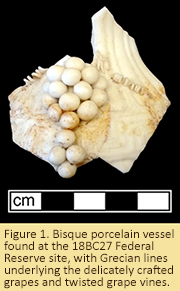Curator's Choice 2018
Bennington Parian: A Look at Exquisite Craftsmanship
July 2018
By Sara Franklin,
MAC Lab Volunteer
 This intriguing piece of ceramic (Figure 1) was recovered from a mid-19th century brick-lined privy, part of the Federal Reserve site (18BC27), a three-block area located in downtown Baltimore. Construction was already under way for the bank building when workers discovered the foundations of the original neighborhood including this privy. Archaeologists were contacted but only had a three-week window to excavate, collect and analyze Feature 23 as well as several other features.
This intriguing piece of ceramic (Figure 1) was recovered from a mid-19th century brick-lined privy, part of the Federal Reserve site (18BC27), a three-block area located in downtown Baltimore. Construction was already under way for the bank building when workers discovered the foundations of the original neighborhood including this privy. Archaeologists were contacted but only had a three-week window to excavate, collect and analyze Feature 23 as well as several other features.
 Historical information shows this privy was located at 522 Sharp Street, property owned in the mid-19th century by Samuel Guest, a real estate broker in Baltimore. Guest rented this lot out to people, one of whom was Dr. Dennis McKew (1829-1885), a well-known and highly-recommended doctor in the Baltimore area.
Historical information shows this privy was located at 522 Sharp Street, property owned in the mid-19th century by Samuel Guest, a real estate broker in Baltimore. Guest rented this lot out to people, one of whom was Dr. Dennis McKew (1829-1885), a well-known and highly-recommended doctor in the Baltimore area.
The significance of this parian porcelain vessel is that it was for decorative purposes only and indicates that this household had some disposable income. The design shows exquisite craftsmanship and beautiful details, including delicate Grecian lines around the body as well as beautifully-crafted three-dimensional grapes, leaves, a small flower and twisted grape vines wrapped around the entire vessel.
This vessel may have been made in Bennington, Vermont by the Fenton Works Pottery founded in 1847 by Christopher Webber Fenton (later renamed the United States Pottery). He experimented with reproducing Rockingham ware, refined white earthenware and yellow wares. Fenton was also fascinated with the bisque porcelain called Parian ware that was popular in England. He is believed to have produced intricate works, like the cologne bottle dating circa 1847-1858 shown in Figure 2 .
.
There are many similarities between the Baltimore artifact and the cologne bottle, but, it is impossible to determine if the privy vessel was a cologne bottle. But one can see how intricate some of designs on parian porcelain could be; from the carefully-placed grapes and twisted vines to the delicate archway designs on the body and the feathered leaves. Each piece was in a sense: one of a kind.
| References |
| Barret, Richard Carter |
| 1958 |
Bennington Pottery and Porcelain. Random House Publishing, New York. |
|
| Brooke, Bob |
| 2018 |
Parian Ware-Affordable Art for the Masses. The Antiques Almanac. Website accessed June 29, 2018 at http://theantiquesalmanac.com/parian.htm |
|